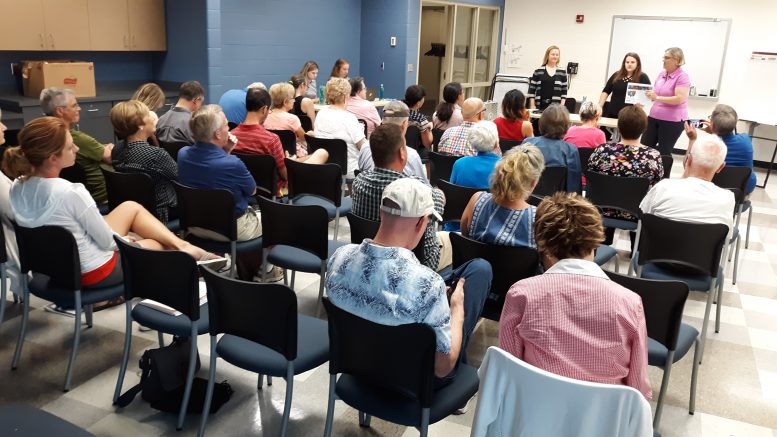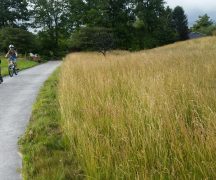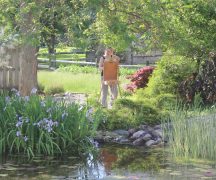By JAN LARSON McLAUGHLIN
BG Independent News
Bowling Green citizens identified the opportunities and threats to Simpson Garden Park Tuesday evening. Nearly 40 residents talked about how to save the city’s “gem” and how to make it more affordable to maintain.
The public forum, coordinated by Dr. Shannon Orr, from BGSU public administration studies, involved citizens brainstorming about the space.
The citizens easily rattled off how the community uses the park for walking dogs, enjoying scenery, playing Pokemon, taking prom and wedding photos, hunting for Easter eggs, walking, biking, running, taking garden tours, learning in education classes, collecting seeds from native plants, performing yoga, and children playing.
But changes are on the horizon – some which will require the park to evolve. For example, climate change could call for drastic modifications.
“We need to think how climate change will affect the landscape,” Orr said.
The park may need to focus more on perennials and less on annuals to keep down costs, and conservation of water usage may be needed.
Plants and grasses that require less water and are drought resistant may be added. The deer and fox populations may grow as other areas suitable for them decrease. And community gardens may be planted on the site.
The expense of maintaining the garden park is also a concern – with the city using $200,000 a year on the site now.
“Beautiful parks don’t come cheap,” Orr said.
The strengths of the park are many – with citizens listing off their favorites.
“It’s a public nature space in an area that doesn’t have many,” Orr said.
The park is home to many native plants, it offers therapeutic refuge for people, it provides habitat for pollinators, and a layover for Monarch butterflies as they migrate.
Simpson Garden Park hosts a nationally recognized hosta garden, a children’s garden, and a way that people can publicly memorialize loved ones.
“I think, in retrospect, what they have been able to do there with a small staff and budget is remarkable,” Nadine Edwards said.
One of the other “strengths” listed was the “hint of wilderness” at the park. But some, especially the neighbors along the park’s edge, see that as a weakness.
The lack of maintenance, and the efforts to try long grasses in the park to lessen mowing costs, were seen as deficiencies to neighbors.
“I can’t see the park,” one neighbor said. The park, she added, was intended to be for gardens, not wilderness. “It’s not Wintergarden Park.”
Another neighbor said she can’t walk her small dog in the tall grass, and she fears snakes or skunks coming out from the grasses.
Some of the neighbors see the lack of maintenance as a threat to the park.
“It’s not the beautiful garden park that we were promised,” one said. “Even when they mow, they don’t mow it very short.”
However, others at the forum liked the waving grasses, and felt the park neighbors having more say than other city residents was a threat to the park.
Karen Woods suggested that citizens could benefit from learning about other garden parks.
“We’re kind of insulated here. The garden world is exploding with possibilities,” she said. And climate change may force some evolution.
Other weaknesses identified included the expense of maintaining the site, and the dependence on a small group of volunteers.
“Many of the volunteers there are aging,” Roger Anderson said.
The gardens are labor intensive, and will need to evolve to be sustainable, Woods said.
“The future’s not going to be hostas and petunias,” she said.
The park also suffers from being a “hidden” gem.
“I run into people who don’t even know it exists,” Anderson said.
The next step at the forum was to identify “opportunities” for the garden park. Some of those ideas included:
- Encourage more collaboration with BGSU and with BG High School FFA.
- Get sponsorships to support particular gardens within the park.
- Increase the native grass population to reduce labor and cost.
- Reduce the carbon footprint, and be environmentally conscious.
- Combine more art with nature.
- Seek traveling exhibits.
- Make better use of the amphitheater.
- Show movies under the stars.
- Attract more birds to the site.
- Host more hands-on classes.
- Bring more music to the park.
- Allow the planting of vegetable or fruit gardens.
- Offer storytime in the children’s area.
- Remain a spacious open area for apartment dwellers.
But the garden park would still be low on funding and lacking in volunteers.
So Mayor Dick Edwards suggested a revival of the Friends of Simpson Garden Park. “We have to grow the giving base,” he said.
And John Calderonella, a former board member of the county park district, suggested that the city park and rec department needs a volunteer coordinator. The county park system has a wealth of volunteers, he said.
“If we want this to be a gem, we need a volunteer coordinator,” Calderonella said.
The volunteers could help with maintenance, he added.
The garden park must be sustained, said Bowling Green City Council member Sandy Rowland.
“This is something worth protecting,” she said. “I want to see it remain a gem in the crown of the city.”
Tuesday was the first of five public forums to be held on the city’s parks. The next will focus on Ridge and Carter parks, and will be held Nov. 13, at 7 p.m. in the community center. Anyone wanting to email comments may send them to Orr at skorr@bgsu.edu.





